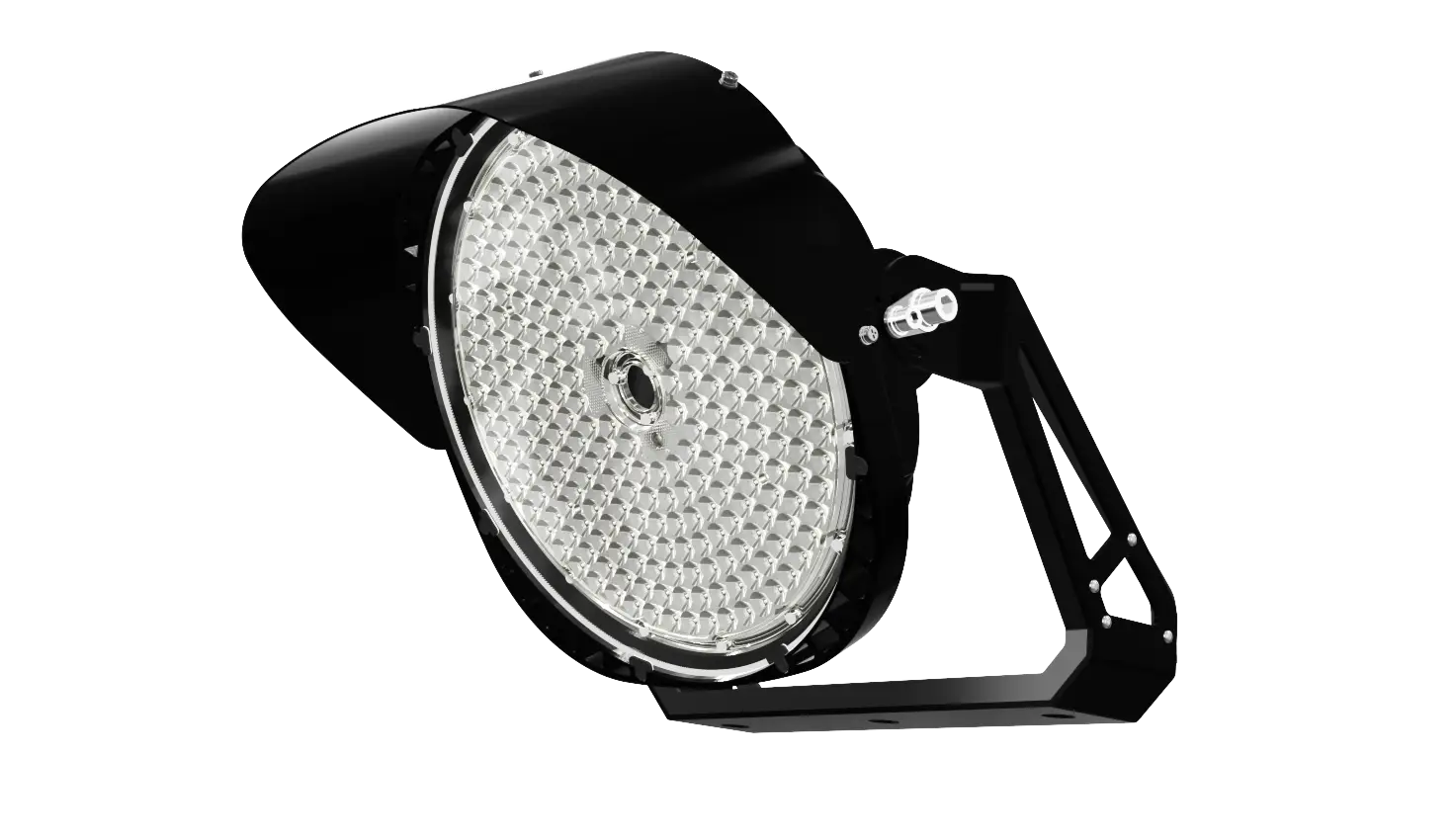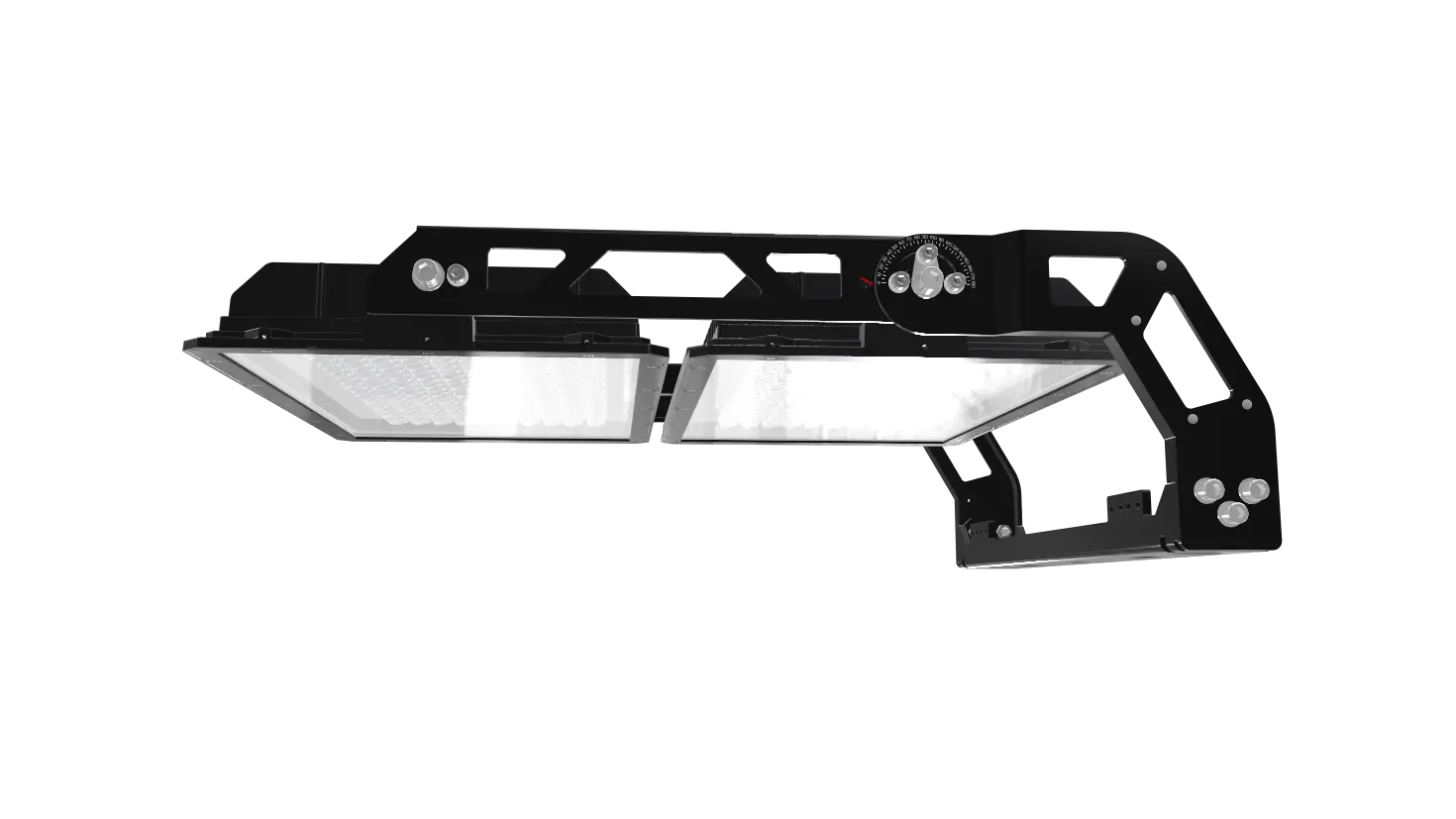为什么你应该选择LED棒球场照明灯?
照明对于棒球比赛至关重要——它能保障球员安全,提升比赛表现,并让球迷不错过任何精彩瞬间。但像金属卤化物灯这样过时的照明设备呢?它们需要15-20分钟的预热时间,能耗高出30%,而且寿命短。正因如此,LED棒球场照明灯正在迅速普及:它们亮度高、节能高效,而且经久耐用。
本指南详细介绍了选择 LED 灯的关键原因,以及如何根据您的场地(少儿棒球联盟、职业棒球联盟或休闲棒球联盟)选择合适的流明度,以便您可以做出明智的长期选择。
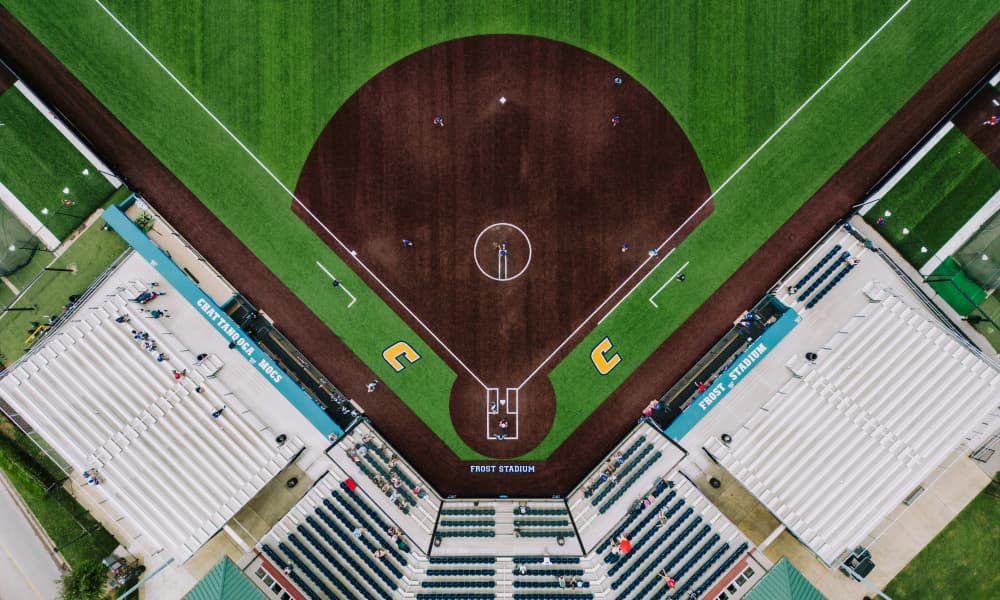
目录:
1. 什么是LED棒球场照明灯?
LED棒球场照明灯是专为照亮整个比赛区域而设计的高功率泛光灯。与老式金属卤化物灯不同,这些LED灯具可瞬间达到全亮度,具有卓越的能源利用率,并且使用寿命显著延长。
为了实现场地内均匀的光线分布,这些LED灯安装在场馆的灯杆上。它们的安装高度和投射角度都经过预先精确计算。精心设计的照明系统能够有效减少眩光、降低阴影区域并消除暗区,从而为运动员创造一个安全、公平的比赛环境。
现代棒球场照明灯还具备精确的光束控制功能。利用这一功能,这些灯具能够在满足棒球场严格照明要求的同时,将能耗降低约60%。
此外,它们还配备坚固的外壳和出色的耐候性,无论是在小型社区公园球场还是大型专业体育场馆,都能可靠运行。
总而言之,LED棒球场照明灯集强大的照明能力、卓越的节能性能和稳定的光输出于一体,是现有棒球场照明设施的理想选择,也是升级老旧照明系统的理想之选。
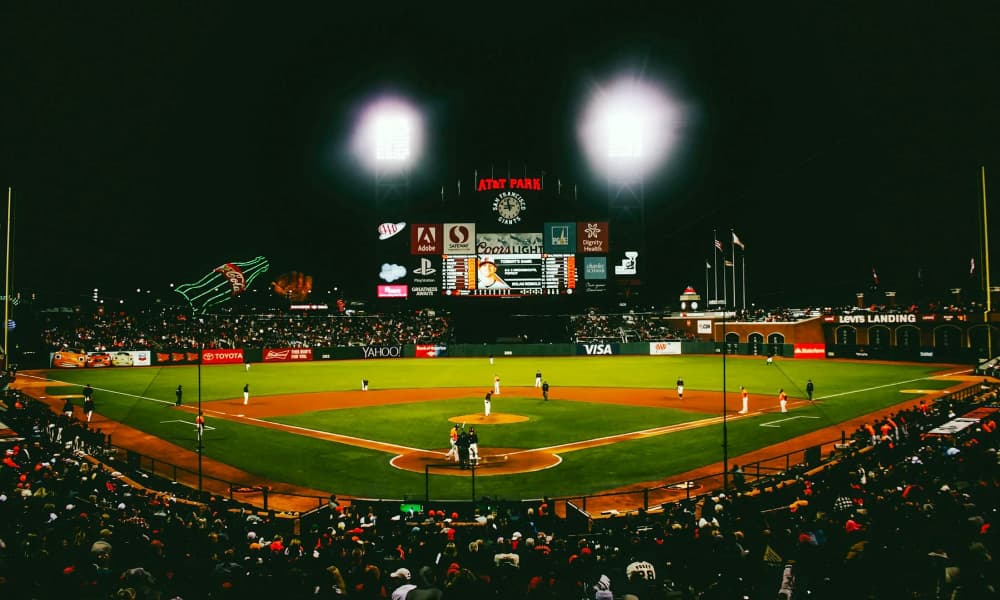
2. 运动场地传统照明与LED照明的比较
棒球场长期以来一直依赖传统的高强度气体放电灯(HID灯),主要是金属卤化物灯(MH) 和高压钠灯(HPS)。虽然这些系统曾经是标准配置,但它们也存在明显的缺点。
1 MH灯发出明亮的白光,但存在预热时间长、光通量衰减快的问题。
高压 钠灯效率更高,但发出黄橙色的光,可见度和显色性较差。
随着人们对照明效果、能源效率和维护成本的要求日益提高,这些老旧的照明技术正逐渐被LED棒球场照明灯所取代。LED灯不仅克服了金卤灯和高压钠灯的局限性,还具有启动迅速、光照质量更高、使用寿命更长等诸多优势。
以下对比突出了棒球场用金属卤化物灯 (MH)、高压钠灯 (HPS) 和 LED 照明解决方案之间的核心区别:
对比:金卤灯 vs 高压钠灯 vs LED灯

简而言之,LED棒球场灯兼具效率、耐用性和卓越的可见性,明显 优于 MH和HPS灯,使其成为现代体育照明升级的标准。
3. 为什么棒球场要选择LED照明?
棒球场照明改用 LED 灯不仅仅是技术问题,它还能为运营者、球员和观众带来实际的好处。
(1)降低运营成本
与高强度气体放电灯 (HID) 或金属卤化物灯 (MH) 相比,LED 灯可降低高达 70% 的能耗。对于社区运动场而言,这意味着每个赛季可节省数千美元。降低能耗也有助于实现可持续发展目标。
(2)最低限度的维护
LED灯的使用寿命可达5万至10万小时,比传统灯泡需要的更换次数少得多。更少的灯泡更换次数意味着更少的停机时间和更低的维护成本。
(3)更好的比赛条件
LED灯提供稳定的亮度和高显色性(CRI)。球员更容易追踪球的轨迹,夜间比赛的体验也更接近白天。阴影和暗区被最小化,提高了场上安全性。
(4)改善观众体验
均匀的照明可以提升看台上的可视性,并改善现场直播的效果。球迷们可以清晰地观看比赛,不会出现眩光或闪烁,从而提升观赛体验。
(5)灵活控制
LED系统与智能控制系统集成,操作人员可以根据训练、正式比赛或特殊活动的需求调节亮度。调光、分区和定时功能均可实现——这是老式系统无法比拟的。
(6)面向未来的投资
虽然前期投入较高,但长期来看,节省的能源和维护成本能带来丰厚的回报。许多设施几年内就能收回投资。
简而言之,棒球场选择 LED 照明意味着更安全的比赛、更低的电费和更好的球迷体验。
4. 如何选择最佳的LED棒球场照明灯?
选择合适的LED棒球场照明灯不仅仅是挑选灯具那么简单——还要考虑场地类型、比赛级别和长期预算。以下是如何做出明智选择的方法。
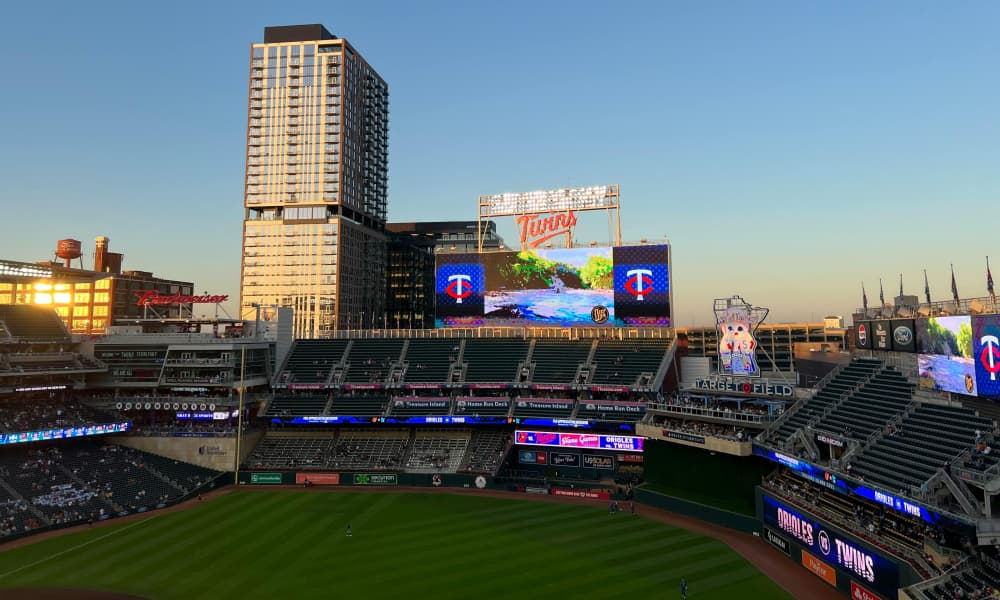
① 定义场地类型和竞争级别
不同游戏级别的照明需求各不相同:
l 休闲/少儿棒球联盟:30-50 英尺烛光,通常 20-30 场比赛。
高中 /大学:50-70 英尺烛光,大约 30-60 个灯具。
l 专业体育场: 70–100+ 英尺烛光,通常有 100+ 场比赛。
了解您的水平可以确定亮度和灯具数量的基准。
② 匹配功率和流明
要看流明数,而不是瓦数。 例如,一个1200瓦的LED灯具可以产生16万流明以上的亮度。休闲运动场地可能需要150万到200万流明的总亮度,而专业体育场馆的亮度可能超过800万流明。务必在灯具输出和灯杆位置之间取得平衡。
③ 光束角度和光学系统
窄光束(15–30°)适用于高杆远距离照射,而宽光束(40–60°)则可将光线均匀照射到内场或观众区。混合光束设计确保了均匀的照明范围,且无阴影。
④ 杆高和位置
典型的灯杆高度范围为 40-100 英尺。较小的场地使用 40-60 英尺,而体育场通常需要 80-100 英尺。正确的间距和瞄准与高度同样重要,以避免眩光和光斑。
⑤ 耐用性和防护性
户外棒球场LED灯必须能够经受 雨水、灰尘和风的考验。应选择防护等级为IP65+且外壳耐腐蚀的产品。在沿海地区,应选择耐盐蚀涂层以延长使用寿命。
⑥ 控制选项
现代系统提供调光、定时器和遥控功能。智能管理每年可降低运营成本10%至20%,从而提高投资回报率。
⑦ 符合标准
务必查阅 IES或CIE照明指南。专业的照明光度设计可确保您的场地在安装前符合安全和可见度标准。
以下是一份简要的检查清单。按照这份清单,您将选择到性能持久、节能高效且具有专业照明效果的LED棒球场照明灯。
字段类型/级别 | 目标英尺烛光 | 所需总流明数 | 固定装置数量 (约) | 杆高范围 |
休闲/少儿棒球联盟 | 30–50 fc | 150万至200万 | 20–30 | 40–60 英尺 |
高中/大学 | 50–70 fc | 3M – 5M | 30–60 | 60–80 英尺 |
专业体育场 | 70–100+ fc | 6个月 – 8个月以上 | 100+ | 80–100 英尺 |
5. 棒球场照明灯的价格是多少?
LED棒球场照明的成本取决于多种因素:场地大小、比赛级别、所需灯具数量以及安装复杂程度。除了购置价格外,长期节能和维护成本的节省也会影响总拥有成本。
5.1 初始购买和安装成本
① 灯具价格:单个高品质 LED 运动灯(1000-1500W 等效)的价格通常在每台 800 美元到 2000 美元之间。
② 灯具数量:
l 小联盟球场(垒间距 60-70 英尺)通常需要 20-30 个固定装置。
高中/大学场地(90 英尺垒距,更大的外场)需要 30-40 个固定装置。
l Professional fields may require 60+ fixtures to meet broadcast-level lighting standards.
③ Poles & Mounting: Poles, brackets, and cabling add significant cost, often accounting for 30%–40% of the total budget.
④ Installation Labor: Professional installation (pole erection, wiring, aiming) can add another $20,000–$50,000, depending on the site conditions.
On average, a Little League field may cost $80,000–$120,000 for a full LED system, while a professional stadium can exceed $500,000.
5.2 Operating & Maintenance Costs
Energy Consumption: LED lights use 40%–60% less electricity than metal halide or HPS lamps. A full field setup may consume 30–50 kW per game, compared to 60–100 kW with traditional lights.
Maintenance: LEDs offer 50,000–100,000 hours of lifespan, reducing the need for frequent bulb replacement and lift-truck rental. Over a decade, this can save tens of thousands of dollars compared to traditional systems.
5.3 Return on Investment (ROI)
Switching to LED is not only about better lighting—it’s also a financial decision.
① Energy Savings: Lower power bills quickly add up. A mid-sized field can save $10,000–$20,000 annually on electricity.
② Reduced Maintenance: Avoiding frequent bulb replacements and labor reduces annual expenses by another $5,000–$10,000.
③ Payback Period: Most fields see a 3–6 year ROI, after which the system continues delivering savings.
Added Value: Brighter, uniform, and flicker-free lighting enhances player performance, fan experience, and even broadcasting opportunities—indirectly contributing to revenue growth.
6. Baseball Field Lighting Design & Installation
Designing and installing LED lighting for a baseball field is more than just putting fixtures on poles—it requires a balance of engineering, safety, and visual performance. The goal is to achieve uniform brightness, minimal glare, and reliable coverage across the infield and outfield.
Below are the most common mounting and installation methods used for baseball field lights.
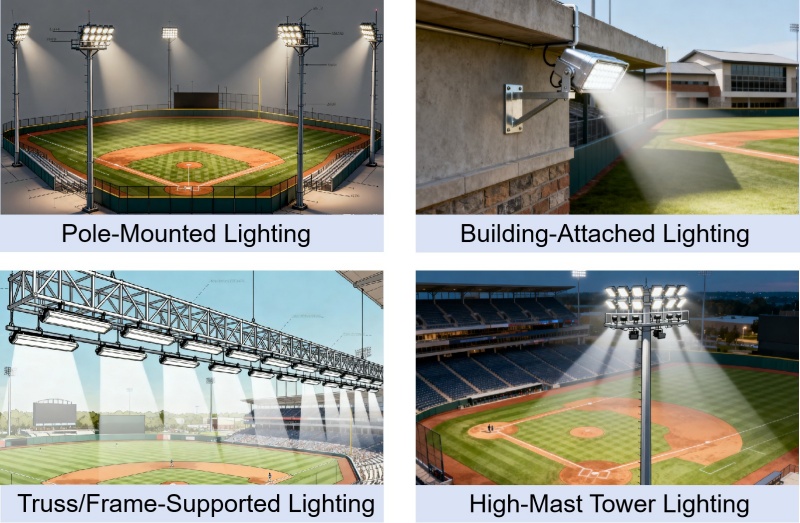
6.1 Pole-Mounted Lighting
l Most common solution for community, school, and semi-professional fields.
l Poles are typically 40–100 ft tall, depending on field size and level of play.
l Materials include galvanized steel or aluminum to withstand wind, rain, and long-term exposure.
l Fixtures are mounted at specific angles (usually 15°–60° beam angles) to avoid shadows and provide smooth coverage.
l For small fields (Little League), 4–6 poles may be enough, while full-size stadiums require 6–8 or more.
Advantage: Flexible for different field sizes, cost-effective for schools and community sports.
Limitation: Requires sufficient space around the field perimeter.
6.2 Wall- or Roof-Mounted Lighting
l Used when the field is close to school buildings, gym walls, or nearby structures.
l Eliminates the need for poles, reducing installation cost and space requirements.
l Works well for smaller training fields or urban locations where space is limited.
Advantage: Saves pole installation cost.
Limitation: Limited mounting height may reduce lighting uniformity for larger fields.
6.3 High-Mast Tower Lighting
l Ideal for multi-purpose stadiums or larger baseball complexes.
l Poles or towers can reach 150–250 ft, allowing a wide beam spread across the entire field.
l High masts often support multiple fixtures per tower, reducing the number of poles required.
Advantage: Excellent coverage, fewer poles needed.
Limitation: Higher upfront cost and engineering requirements.
6.4 Truss or Frame-Mounted Lighting
l Common in college and professional stadiums where poles near the field would obstruct sightlines.
l Fixtures are mounted on roof trusses, structural frames, or catwalks above the stands.
l Provides excellent lighting angles from above, ensuring uniform illumination for both players and broadcast cameras.
Advantage: No poles on the field perimeter, better viewing experience for fans.
Limitation: Only suitable for large stadiums with strong structural support.
6.5 Key Design Considerations
l Beam Angle & Positioning: Avoids shadows and dark spots in the outfield.
l Uniformity Ratio: Target of 0.5 or higher ensures balanced light across the field.
l Glare Control: Anti-glare lenses and shielded optics help protect players’ and spectators’ eyes.
l Weather Durability: Fixtures must be IP65+ rated to resist rain, wind, and dust.
Wiring & Power: Underground conduits and weatherproof connections ensure safety and reliability.
7. Conclusion
LED baseball field lights have become the clear choice for modern sports facilities. Compared with traditional HID, metal halide, or high-pressure sodium lamps, LEDs deliver higher efficiency, longer lifespan, and far lower maintenance. They also provide consistent brightness and meet strict baseball field lighting standards for both infield and outfield play.
From cost savings on energy to flexible design options with poles, masts, or trusses, LEDs make it easier to achieve professional-level visibility. Whether planning for a local league, high school, or professional stadium, the right design ensures proper lumen output, correct mounting height, and uniform coverage.
Investing in LED baseball field lights is not just a short-term upgrade—it is a long-term solution that improves player safety, spectator experience, and operational efficiency.
8. FAQs
8.1 How Many Lumens Are Needed to Light a Baseball Field?
The lumen requirement depends on the competition level. Little League or recreational fields may need 30,000–50,000 lumens per fixture, while high school and college fields often require 70,000–100,000 lumens per fixture. Professional stadiums with TV broadcasting can exceed 200,000 lumens per fixture. The goal is to reach 30–100 foot-candles on the infield and 20–50 foot-candles on the outfield.
8.2 What's the Best Height to Mount Baseball Field Lights?
小型场地通常使用 40-60 英尺高的灯杆。高中或社区场地通常使用 60-80 英尺高的灯杆。大型体育场可以使用 100 英尺或更高的灯杆,以获得更好的覆盖范围并减少眩光。合适的灯杆高度取决于光束角度、灯杆位置和场地大小。安装过低会产生阴影,而过高则会降低效率。
8.3 一个棒球场需要多少盏体育场照明灯?
球场照明灯的数量取决于场地大小和比赛级别。少儿棒球联盟的场地可能需要20-30盏灯,而高中或大学球场通常需要30-60盏灯。专业体育场可能需要100多盏灯,安装在灯杆、桅杆或桁架上。照明灯的布局与数量同样重要——内场和外场的均匀分布可以确保球员始终能够看到球。
8.4 运行棒球场照明灯需要多少成本?
运行成本取决于功率、灯具数量和使用时长。一个典型的高中操场,如果安装40盏功率为1200瓦的LED灯具,每小时耗电约48千瓦时。按每千瓦时0.12美元计算,每小时耗电成本约为6美元。
由于功率较高且效率较低,老式金属卤化物灯系统的成本可能是LED灯的2-3倍。LED灯可以显著降低运行成本,尤其是在结合调光控制和定时开关功能时。
相关产品
_thumb.jpg)
